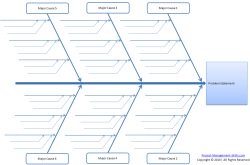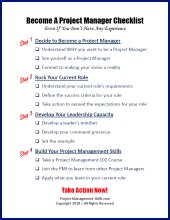Problem Solving Techniques for Project Managers
Learn which problem solving techniques and strategies can help you effectively handle the challenges you face in your projects.
Problem Solving Techniques: A 5-Step Approach
Some problems are small and can be resolved quickly. Other problems are large and may require significant time and effort to solve. These larger problems are often tackled by turning them into formal projects.
"A project is a problem scheduled for solution."
- Joseph M. Juran
Problem Solving is one of the Tools & Techniques used for Managing Quality and Controlling Resources.
Modules 8 and 9 of the PM PrepCast cover Project Quality Management and Project Resource Management.
Consider this study program if you're preparing to take your CAPM or PMP Certification exam.
Disclosure: I may receive a commission if you purchase the PM PrepCast with this link.
Whether the problem you are focusing on is small or large, using a systematic approach for solving it will help you be a more effective project manager.
This approach defines five problem solving steps you can use for most problems...
- Define the Problem
- Determine the Causes
- Generate Ideas
- Select the Best Solution
- Take Action
Define the Problem
The most important of the problem solving steps is to define the problem correctly. The way you define the problem will determine how you attempt to solve it.
For example, if you receive a complaint about one of your project team members from a client, the solutions you come up with will be different based on the way you define the problem.
If you define the problem as poor performance by the team member you will develop different solutions than if you define the problem as poor expectation setting with the client.
Determine the Causes
 Fishbone Diagram
Fishbone DiagramOnce you have defined the problem, you are ready to dig deeper and start to determine what is causing it. You can use a fishbone diagram to help you perform a cause and effect analysis.
If you consider the problem as a gap between where you are now and where you want to be, the causes of the problem are the obstacles that are preventing you from closing that gap immediately.
This level of analysis is important to make sure your solutions address the actual causes of the problem instead of the symptoms of the problem. If your solution fixes a symptom instead of an actual cause, the problem is likely to reoccur since it was never truly solved.
Generate Ideas
Once the hard work of defining the problem and determining its causes has been completed, it's time to get creative and develop possible solutions to the problem.
Two great problem solving methods you can use for coming up with solutions are brainstorming and mind mapping.
Select the Best Solution
After you come up with several ideas that can solve the problem, one problem solving technique you can use to decide which one is the best solution to your problem is a simple trade-off analysis.
To perform the trade-off analysis, define the critical criteria for the problem that you can use to evaluate how each solution compares to each other. The evaluation can be done using a simple matrix. The highest ranking solution will be your best solution for this problem.
Pass your PMP Exam!
The PM Exam Simulator is an online exam simulator.
Realistic exam sample questions so you can pass your CAPM or PMP Certification exam.
Disclosure: I may receive a commission if you purchase the PM Exam Simulator with this link.
Take Action
Once you've determined which solution you will implement, it's time to take action. If the solution involves several actions or requires action from others, it is a good idea to create an action plan and treat it as a mini-project.
Using this simple five-step approach can increase the effectiveness of your problem solving skills.
For more problem solving strategies and techniques, subscribe to my newsletter below.
Related Articles About Problem Solving Techniques
Fishbone Diagram: Cause and Effect Analysis Using Ishikawa Diagrams
A fishbone diagram can help you perform a cause and effect analysis for a problem. Step-by-step instructions on how to create this type of diagram. Also known as Ishikara or Cause and Effect diagrams.
Do You Want More Project Management Tips?

Subscribe to Project Success Tips, my FREE Project Management Newsletter where I share tips and techniques that you can use to get your Project Management Career off to a great start.
As a BONUS for signing up, you'll receive access to my Subscribers Only Download Page! This is where you can download my "Become A Project Manager Checklist" and other project management templates.
Don't wait...


New! Comments
Have your say about what you just read! Leave me a comment in the box below.